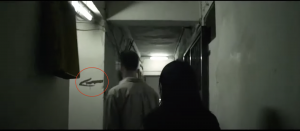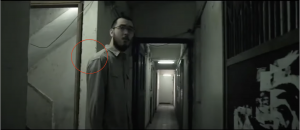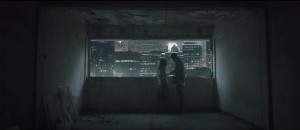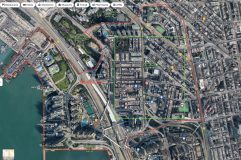Ten Years – Season of the End, Wong Fei Pang (2015)
Tai Kok Tsui, Hong Kong
The film Season of the End is set inside a tong lau in Tai Kok Tsui. The story happened in a studio where specimen is created and stored. The story started with couple making specimen of everything that is inside different broken houses as a sense of preservation. They believe the creation of specimen does not only preserve physical object, but it preserves the history, thoughts and culture. The story end with the female lead making the specimen of the male lead as they questioned is this the only way to preserve freedom.


In the female lead’s dream, they were walking along the corridor inside the building. The male lead walking in front suddenly realised the female lead disappeared, as he returned along the same route to find the female lead, he got lost and went to a new space. Looking at the two screenshot that should be the same position, by comparing the mark on the wall, we know that it is two different spaces in real world, but it is portrayed as a continue corridor inside the movie. The director combines different corridors in each turning point to create a maze with unclear order of space. The maze is a symbolizes of their mind which implies they are frustrated and lost about what they are doing. As the camera showing the more frequent turn they made while walking in the corridor, it represents the increasing level of anxiety. The construction of maze inside the movie causes the two leading characters never meet each other inside the corridor. Different scene showing the two characters not meeting implies they are having different thoughts which lead them walking in different way and not seeing each other.


Another scene seeing the two characters looking at the city view from a huge opening of the building is showing the contrast of world inside and outside the building. Even though it was not mentioned which building the film is set, looking at the map, since the building is old and low rise, it is possible that the building is one of those within the green rectangle. We can see that the surrounding of those buildings is also old tong lau or high-rise residential buildings. Therefore, we can conclude that the city view shown is a montage and the city view does not exist in real life. There are two frames shown in the scenes, the camera frame showing interior space of the building represent the two characters while the opening is another frame which represents the city and the majority. There is huge contrast created in this scene. There is color contrast, the outside world is colorful while the color inside the building is dark and almost black. The outside world is portrayed as attractive, beautiful while inside the building the walls are broken. This helps to further explain the concept of conservation that the old building exists in a modern city. These contrast shows how different the two characters are as compared to the remaining people. They are stressed, pessimistic and struggling should they step back to the outside world as they are looking through the opening.
Gusawir Natalie, 3035794545
Appreciate how you distinguished two different corridors through detailed observation. In fact, if we pay a similar level of attention to different films, we may notice that lots of seemingly connected spaces are actually disjunct in reality. You have demonstrated some effort to conduct virtual fieldwork research as well. To further your understanding, perhaps you could compare the representation of the spaces in the film and that in reality, and apply concepts we have discussed in ‘What Makes the Apartment Complex’ by Wojcik.